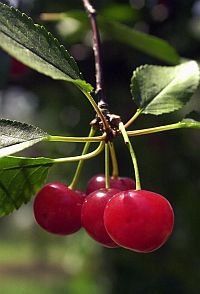 Cherry season is just beginning and Charlie has some tips on how to cultivate your sweets and sours.
Cherry season is just beginning and Charlie has some tips on how to cultivate your sweets and sours.
I’m Charlie Nardozzi and this is the Vermont Garden Journal. One of my fondest childhood memories is picking cherries. Every June, my Uncle Billy would hoist a few cousins and me in the front end loader of his tractor and lift us up into the 40 foot high cherry tree on my grandfather’s farm. We’d pick bushels of red cherries and with stained faces and hands we were happy campers.
To grow your own cherry tree, stick with a dwarf or semi dwarf sour cherry for ease of maintenance. ‘Dwarf Northstar’ only grows 8 feet tall making it perfect for small yards. ‘Meteor’ is similar to Northstar, but produces a larger tree and more fruit. ‘Bali’ is great for cold areas, because it’s hardy to minus 40 degrees. It fruits in August and grows to 15 feet. For all of these, you’ll only need one tree for pollination.
Plant in a full sun on well drained soil. Protect young trees from mice, voles, and deer with fencing and trunk guards. Fertilize annually after fruiting with an organic fertilizer. Cherries need less pruning and pest control than other fruits. The biggest problem is birds – cover dwarf trees with netting or use devices such as scare eye balloons.
For this week’s tip, now that the first flush of perennial flowers has past, deadhead the spent blossoms. Deadheading cleans up the plants and prevents them from self sowing. With some perennials – such as dianthus, salvia, and shasta daisy – deadheading stimulates them to bloom again.
Next week on the Vermont Garden Journal, I’ll be talking about Japanese beetles. For now, I’ll be seeing you in the garden!